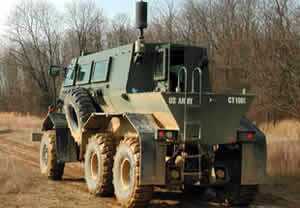 U.S. Army Ordered 27 Buffalo A2 Route-Clearance Vehicles
U.S. Army Ordered 27 Buffalo A2 Route-Clearance Vehicles
(NSI News Source Info) November 2, 2008: On Oct 24. Force Protection, Inc. announced that it has received an additional order under contract W56HZV-08-C-0028 for the delivery of 27 Buffalo A2 route-clearance vehicles. The undefinitized contract modification carries a dollar value not to exceed $26.2 million and fulfills an urgent operational need. These vehicles are to be delivered prior to June 2009. Michael Moody, Chairman and Chief Executive Officer of Force Protection, commented, “We are very pleased to be in a position to respond to incremental needs for the vitally important Buffalo route clearance vehicle. We believe that the unique nature of the vehicle and the importance of the missions it performs will enable us to continue at current rates of production well into the future.” About Force Protection, Inc. Force Protection, Inc. is a leading American designer, developer and manufacturer of life saving survivability solutions and equipment, predominantly ballistic- and blast-protected wheeled vehicles currently deployed by the U.S. military and its allies to support armed forces and security personnel in conflict zones. The Company’s specialty vehicles, the Cougar, the Buffalo and the Cheetah, are designed specifically for reconnaissance, forward command and control, and urban operations and to protect their occupants from landmines, hostile fire, and improvised explosive devices (IEDs, commonly referred to as roadside bombs). The Company also is the developer and manufacturer of ForceArmor™ an armor package providing superior protection against explosively formed projectiles (EFPs) now available for a wide range of tactical-wheeled vehicles. The Company is one of the original developers and primary providers of vehicles for the U.S. military’s Mine Resistant Ambush Protected, or MRAP, vehicle program. For more information on Force Protection and its vehicles, visit www.forceprotection.net. Safe Harbor Language This press release contains forward looking statements that are not historical facts, including statements about our beliefs and expectations are forward-looking statements. These statements are based on beliefs and assumptions by Force Protection’s management, and on information currently available to management. Forward-looking statements speak only as of the date they are made, and we undertake no obligation to update any of them publicly in light of new information or future events. A number of important factors could cause actual result to differ materially from those contained in any forward-looking statements. Examples of these factors include, but are not limited to, our ability to fulfill the above described order on a timely basis, our ability to effectively manage the risks in our business; the reaction of the marketplace to the foregoing; and other risk factors and cautionary statements listed in the Company’s periodic reports filed with the Securities and Exchange Commission, including the risks set forth in the Company’s 2007 Annual Report on Form 10-K for the year ended December 31, 2007.





















